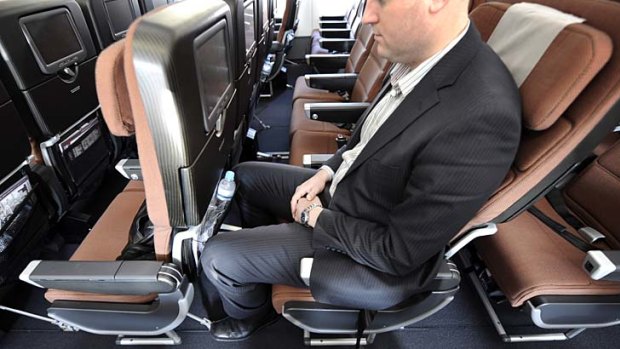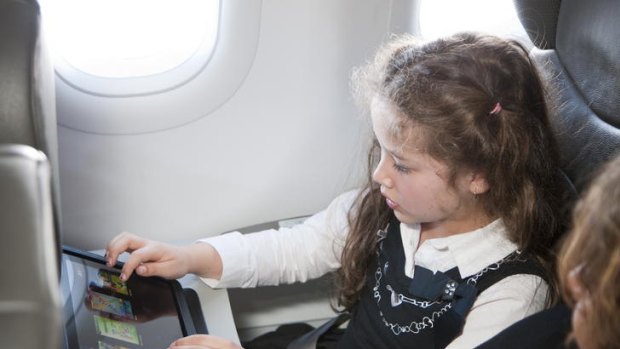This was published 11 years ago
Seat space versus in-flight entertainment

Airlines are regularly looking for ways to squeeze in more seats.Credit: Craig Abraham
I’ve never seen it put so brazenly. The subject was in-flight entertainment (IFE) and the salivation of airline managements about the new generation of technology that promises to save them a poultice in the amount of money they have to spend on delivering “product” to in-seat headphones and video screens.
We’re talking about the new lightweight IFE that is being rolled out in Virgin Australia and Qantas planes via cybertoys like iPads and Samsung tablets – ideally passengers’ own devices – that replace the first generation of expensive, heavy and unreliable systems delivered via kilometres of hot wiring looms fitted to plane fleets.
Aviation writer Mary Kirby, who edits Airline Passenger Experience magazine, was repeating the sort of economic arguments frequently given to her by airline managements.

Airlines, including Jetstar (pictured), are looking at tablet computers as alternatives to installing costly, heavy, in-flight entertainment systems.
“It’s of more value for an airline to add two rows worth of seats and have a good inflight entertainment system rather than do the opposite and give passengers more legroom,” Kirby told Australian online magazine, Technology Spectator.
I’m not shooting the messenger, but it’s good to see it in plain English. In my books, it is confirmation that the airline industry will do anything except what passengers really want. And IFE’s job is to quiet the grumbling of the masses.
As Kirby puts it: “It’s all about distracting the brain from the pain.”
In the meantime, airline passengers are shouting at airline managements: give us more space and more comfort. In surveys, it is consistently rated as the top inflight issue. But airline managements aren’t listening.
Instead, nothing will distract them from their efforts to squeeze passengers into smaller and smaller spaces.
Even the world’s oldest and possibly best low-cost airline is giving up its comfort advantage: Southwest Airlines of the US is reducing the distance between seat rows from 32 to 31 inches (81 to 78 centimetres approximately).
In the meantime, airlines like AirAsia are testing the limits of the human body by squeezing nine-abreast seating into its widebody A330s on flights between Australia and Malaysia, instead of the plane’s usual eight across.
That means the average human bottom width of about 15 inches (38 centimetres – slightly more for females, according to ergonomics experts) are being given just two centimetres of sideways movement in seats that are just 16.7 inches (42 centimetres) wide -even less than standard 737 seats, which are 17 inches (43 centimetres) wide.
But forget these super squeezy seats: even the average economy airline seat is at least five inches (12 centimetres) too narrow for the average human derriere, according Kathleen Robinette, who has been studying human body dimensions for the US Air Force for 30 years.
“One of the most important things about a comfortable seat is the ability to move in it,” Robinette told CNN last week. “You have to be able to readjust your posture every so often for it to stay comfortable.” Otherwise, she said, passengers put themselves at risk of deep vein thrombosis, a serious health condition affecting people prone to blood clots.
Notionally, airline managements keep ramming economy seating closer and closer together to keep lowering unit costs. But that exercise is nearing its limits. At some stage the industry will have to rediscover the mantra that the customer is always right.
Some airlines in our region already do give economy passengers an excellent deal on seating space: carriers including Air China, Korean Airlines, Thai Airways and Malaysia Airlines offer up to 34-inch (86-centimetre) pitch in economy long-haul, even though they barely advertise the fact. Air New Zealand offers 33 inches on some 777 seats, 34 on others. Among low-cost carriers, America’s JetBlue offers 34 inches as standard.
If you were forced to choose, would it be seating comfort or quality in-flight entertainment? Or is value – and therefore ticket price – always the primary consideration?
Sign up for the Traveller Deals newsletter
Get exclusive travel deals delivered straight to your inbox. Sign up now.